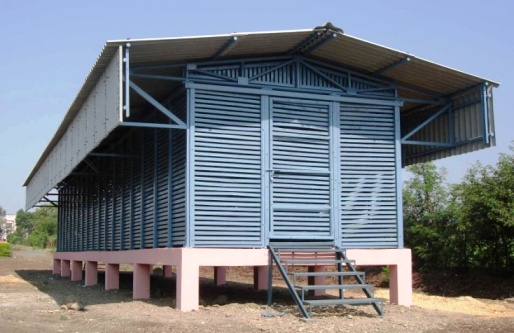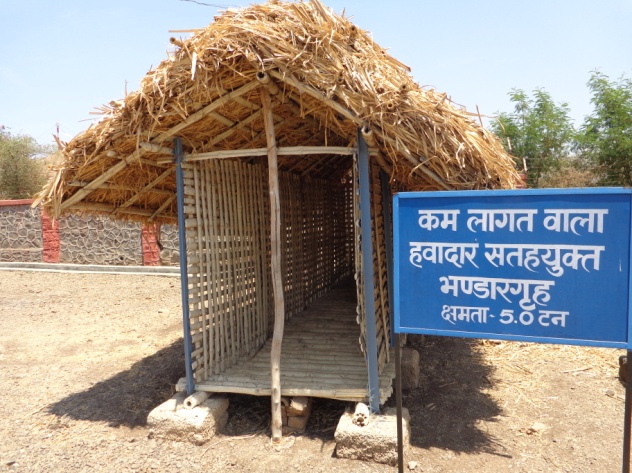Onion is one of the most highly valued vegetable crops and is regularly consumed. However, it is a seasonal crop, and in India, it is cultivated in three crop seasons: Kharif, Late-Kharif, and Rabi. Kharif onion is available in the markets from October to December; Late-Kharif onion is available from January to March, while the Rabi crop is available from April to May. These Rabi-stored onions are used for domestic as well as export markets from May to October. Therefore, it is vital to successfully store Rabi-harvested onions (for nearly 6 months) to maintain the domestic supply and stabilize price fluctuations.
Onion is semi-perishable, and storage losses occur due to weight loss, sprouting, and rotting. These losses are significantly influenced by various biotic and abiotic factors. Among biotic stresses, insect pests and pathogens can cause significant yield losses of 50-70% in onions. Some of the fungal pathogens include Aspergillus spp., Penicillium spp., Alternaria spp., Fusarium spp., Rhizopus spp., Colletotrichum spp., Pseudomonas spp., Lactobacillus spp., Erwinia spp., and Botrytis spp. The key insect pest in storage is the almond moth (Ephestia cautella), which affects product quality through frass, webbings, and direct feeding. Other pests such as thrips, mites, flies, and beetles also contribute to storage losses. Feeding punctures on the bulbs act as entry points for pathogens, exacerbating losses by inducing rot and decay during storage.
Losses during storage depend on several pre- and post-harvest practices. Poor pre-harvest practices, such as inadequate field sanitation and improper curing, create favorable conditions for these pests and pathogens to thrive. Additionally, suboptimal storage conditions, including high humidity and temperature, accelerate the proliferation of these harmful agents. Effective management of these factors through good agricultural practices, integrated pest and disease management (IPDM), proper curing, and maintaining appropriate storage environments is crucial for minimizing storage losses in onions. This article describes the pre- and post-harvest practices that need to be followed to reduce storage losses in onions.
Pre-harvest practices
Variety
Selection of proper variety is important for long term storage of onion. In general, light red varieties have good storage compared to white, dark red and yellow varieties. Among the onion varieties developed by ICAR-DOGR, the storage losses are less in Bhima Shakti and Bhima Kiran compared to other varieties.
Phyto-sanitation
Key practices include selecting disease-free planting materials and ensuring proper crop rotation to reduce pest infestation and pathogen load in the soil. Adequate field sanitation, such as removing plant debris and controlling weeds, helps limit infection sources. Proper irrigation management is essential; excessive moisture can promote fungal growth, so adopting drip irrigation or other water-conserving techniques can reduce humidity levels around the plants. Integrated pest and disease management practices needs to be adopted to reduce the load of insect pests and pathogen.
Fertilizer dosage
Application of recommended dose of fertilizers is important for longer storage life. Storage losses are more in the onion grown under higher dose of nitrogen. Onion grown under higher dose of Nitrogen tends to rot early during storage than those grown under optimum doses which might be due to the increase in the neck thick in the crop that lead more moisture loss as well as more pathological infections.
Irrigation
Irrigation before harvest results in skin splitting and promotes rotting by different fungi, whereas water deficit results in an acceleration of sprouting and increased rate of water loss during storage. Bulbs grown under low soil moisture regime results in higher physiological loss in weight and sprouting. Irrigation should be stopped 10-15 days before harvest of the crop to avoid losses from the rotting during storage.
Post-harvest practices
Harvesting Stage
The stage of harvesting determines the shelf-life of onions. Storage losses at optimum maturity are normally lower than those harvested before the tops collapse. For maximum storage life, onions should be harvested after 50% neck fall. Irrigation should be stopped 10 days before harvesting the crop. In India, onions are generally harvested manually by digging. This should be done carefully by pulling or uprooting the onions from the ground with the tops intact and gently shaking the soil from around the bulbs. Care should be taken to avoid mechanical damage to the bulbs during harvest. Mechanical harvesters, which are specially designed for onion harvesting or modified potato diggers, are also used. However, mechanical damage to the bulbs during harvesting is a main concern with machine harvesting.
Curing
Curing is a drying process intended to dry off the necks and outer scales of the bulbs to prevent moisture loss and decay during storage. It also helps detach soil from the roots, sheds dried roots, and eliminates the chances of microbial infection in storage. For onions, field curing by the windrow method for 2-3 days until the foliage turns yellow, followed by shade curing for 10-15 days, is recommended. Avoid direct sunlight on onion bulbs to reduce sunscald, colour fading, and quality deterioration. After field curing, the removal of foliage is done by leaving a 2-3 cm above the bulb (neck region). Shade curing after field curing is essential to remove the field heat and excess moisture from the surface of the bulbs before packing, transportation, or storage.
Sorting and Grading
Removing undesirable material, rotted and sprouted bulbs at the time of storage, as well as during storage, will keep the onions clean and reduce damage to the bulbs. Storing uniform and good-sized bulbs by proper grading will be beneficial for fetching better market price.
Practices followed during selection or sorting and grading of onion
- The onion must be free of any bacterial or fungal diseases, physiological disorder which substantially affects their appearance, eligibility and storage life
- The onion must not have any damage or injury
- The onion skin must be thin, properly dried, double layered and intact with the bulb
- The fleshy layers of the onion bulb should not be exposed
Transportation
Onions are transported in open trolleys or bullock carts to nearby mandis (markets) or in nylon netted bags of 40-50 kg by trucks for long distances. They are also transported through railway wagons. Care should be taken to avoid mechanical damage during transportation.
Storage environment
The storage environment has a significant impact on the dormancy and storage life of onions. Temperature and relative humidity are of prime importance for the storage of onions. In traditional ambient storage, the lack of proper ventilation increases storage losses in bulk storage. The stacking height also has a profound effect on spoilage. ICAR-DOGR has developed different naturally ventilated storage structures to provide optimum storage conditions. These structures vary in capacity and cost to fulfill the requirements of farmers and traders of all income groups. Onion storage requires high temperatures and low relative humidity conditions. A temperature of 25-30°C and relative humidity of 65-70% is recommended for longer storage life. Low temperature and high relative humidity increase sprouting, while high temperature and low relative humidity increase weight loss. High temperature and high relative humidity conditions increase the rotting of bulbs during storage. Though naturally ventilated storage structures are low-cost, controlling temperature and relative humidity to maintain the desired storage conditions for onions is difficult. Due to this, these structures are not suitable for areas where temperature and relative humidity are very high. Keeping this in view, ICAR-DOGR has also developed controlled storage structures where we can maintain a temperature of 27 ± 2°C and RH of 60-70% with proper ventilation to maintain quality while minimizing sprouting, rotting, and weight loss.
Pest and disease management
Inert dusts like diatomaceous earth, kaolinite clay, and lime powder help manage moisture levels, deter pests, and improve the storage environment. Botanicals, such as essential oils and plant extracts from neem, eucalyptus, and lemongrass, offer a natural way to control pests and diseases, minimizing reliance on synthetic chemicals and promoting sustainability.
Do's and Don'ts able for Onion Storage Structure
- The site selected for the onion storage structure should be well-drained and easily accessible. Water stagnation and deep sites should be avoided.
- The onion storage structure should be naturally ventilated from the lower and other sides.
- There should not be tall civil works close to the structure.
- The width of the onion storage structure should be 610 cm for natural air circulation. In high humidity areas, the width of the storage structure should be less, or there should be a provision for a mechanism for air circulation.
- The length of the onion storage structure should be at a right angle to the direction of the wind (East-West) in single-row type structures. In the case of two-row storage structures, the length should be kept along the direction of the wind.
- The windward side of the storage should have a closing system during storms and heavy rain, with an opening facility when necessary.
- There should be heat-resistant material on the upper side of the roof of the onion storage structure. Do not use galvanized iron sheets for the roof.
Do's and Don'ts for Onion Storage
- Onions should be well cured before storage
- Sorting should be done before storage to remove rotten, immature and damaged bulbs
- Onions should be stored in dry and well ventilated stores at lower humidity (65-70%)
- Rotten, diseased and sprouted bulbs should be removed at regular intervals
- Onions should not be washed before storing
- Avoid storing onions with other fruits and vegetables
Conclusion
Storage of onion with minimum storage losses is important to reduce the demand and supply gap that creates havoc in the country with increased price. Storage losses in onion depend on several pre and post-harvest practices. By following the above described pre and post-harvest management practices storage losses can be curtailed.

Figure 1: Post-harvest practices in onion

Figure 2: Naturally ventilated storage structures for onion

Figure 3: (A) Bulb damaged by almond moth; (B) Black mould infestation
Authors:
*Kalyani Gorrepati, Soumia P. S., Bhushan Bibwe and Dhananjay V. Shirsat
ICAR-Directorate of Onion and Garlic Research, Pune, Maharashtra
*Corresponding author:
